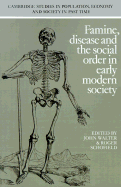Book contents
- Frontmatter
- Contents
- List of contributors
- List of figures
- List of tables
- Andrew Appleby: A personal appreciation
- A bibliography of Andrew B. Appleby's principal works in chronological order
- List of abbreviations
- 1 Famine, disease and crisis mortality in early modern society
- 2 The social economy of dearth in early modern England
- 3 Death in Whickham
- 4 The response to plague in early modern England: public policies and their consequences
- 5 Demographic crises and subsistence crises in France, 1650-1725
- 6 Markets and mortality in France, 1600–1789
- 7 Some reflections on corn yields and prices in pre-industrial economies
- 8 Family structure, demographic behaviour, and economic growth
- Consolidated bibliography
- Index
- Cambridge Studies in Population, Economy and Society in Past Time
3 - Death in Whickham
Published online by Cambridge University Press: 01 June 2011
- Frontmatter
- Contents
- List of contributors
- List of figures
- List of tables
- Andrew Appleby: A personal appreciation
- A bibliography of Andrew B. Appleby's principal works in chronological order
- List of abbreviations
- 1 Famine, disease and crisis mortality in early modern society
- 2 The social economy of dearth in early modern England
- 3 Death in Whickham
- 4 The response to plague in early modern England: public policies and their consequences
- 5 Demographic crises and subsistence crises in France, 1650-1725
- 6 Markets and mortality in France, 1600–1789
- 7 Some reflections on corn yields and prices in pre-industrial economies
- 8 Family structure, demographic behaviour, and economic growth
- Consolidated bibliography
- Index
- Cambridge Studies in Population, Economy and Society in Past Time
Summary
The emergence of historical demography in the decades since the Second World War has rendered English historians only too familiar with the demographic facts of mortality in the Tudor and Stuart period. The jagged peaks in burial statistics derived from the aggregative analysis of Anglican parish registers are in themselves sufficient to lacerate the complacency of a western culture in which death, though inevitable, has become postponed, confined, effaced from public view and muted in public consciousness. The patient piecing together of marriages, baptisms, and burials in family reconstruction studies demonstrates less dramatically, but in more compelling detail, the stark realities of an age in which high infant and child mortality and the premature deaths of spouses were perennial threats to the survival of the individual family. Graphs, tables and histograms, simulations and back-projections, the proliferating weaponry of the demographic arms race, combine to bring home to the modern student what every contemporary knew: that life was tenuous; that few could hope to live out the biblical span and die already retired from the immediacy of family responsibilities; that for most death came both unexpected and untimely, cutting them off quite literally in the midst of life.
The facts of a demographic regime in which high mortality was a central characteristic are clear enough.
- Type
- Chapter
- Information
- Famine, Disease and the Social Order in Early Modern Society , pp. 129 - 166Publisher: Cambridge University PressPrint publication year: 1989
Accessibility information
- 3
- Cited by

